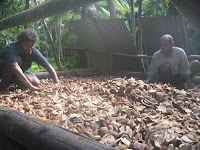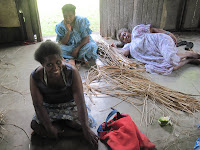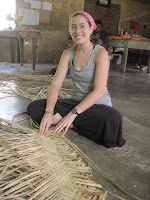When you think of islands in the south pacific what comes to mind? Long sandy beaches? Lush green jungle? Tall coconut trees? The coconut trees here are amazing. Their trunks can be used for wood. The leaves for baskets, brooms, fire starters and mats. The coconuts are essential for drinking and food.
One of the most common ways for the locals to make money is by selling copra. Coconuts grow wherever one is germinated but the locals are proactive about planting them into plantations. When the plantations have lots of dry coconuts that have fallen down it is a perfect time to make copra. Copra is the dried "meat" of the coconut.
First the dry brown coconuts are heaped into piles. This in itself is a days work. Then Mama (she's the pro) will come through and chop the coconuts in half with one strong whack with an axe. I tried a few heaps. Each coconut took 3 or 4 whacks to break apart and I wasn't always right down the middle...oops. I also was so busy focusing on the coconuts that I accidentally stepped in cow poo...oops again.
Papa comes behind to lay out both sides of the coconut and take out any navara that has grown inside. Navara is when the coconut water starts to consolidate to make a cotton candy type consistency. The coconuts then dry in the sun for a day or two.
The next step involves a lot of team work. They do this together because they can talk and work at the same time and share the load. Using a special tool they scrape the meat out of the coconut husk.
The chunks of coconut "meat" are then dried using smoke from fire for a day or two. We are sorting the pieces to see which are finished and which need to be smoked more.
Papa is building the fire underneath the copra bed.
The dried copra is then sold to a local store. The locals make about 25,000 vatu (about 250 USD) per ton. The local store sends the bags to Santo island for processing. Coconut oil is extracted from it and the rest is used to make copra meal. This copra meal is full of protein but has too much fiber in it to be consumed by humans. The copra meal is perfect though for horses and cattle.
This is not an easy way to make money since it involves many steps and physical labor but if you put in the work you can get the reward. The locals work together to help each other and it can be a fun social event too.






























